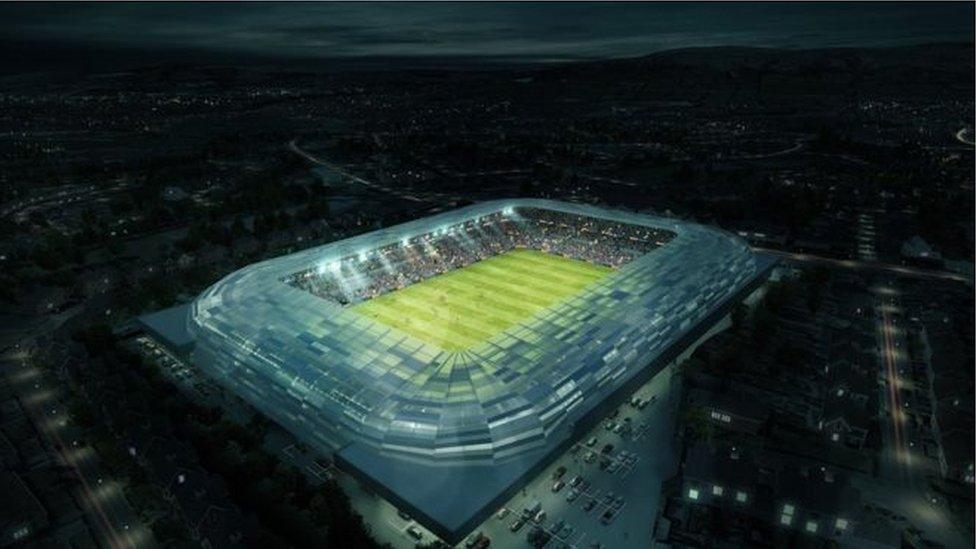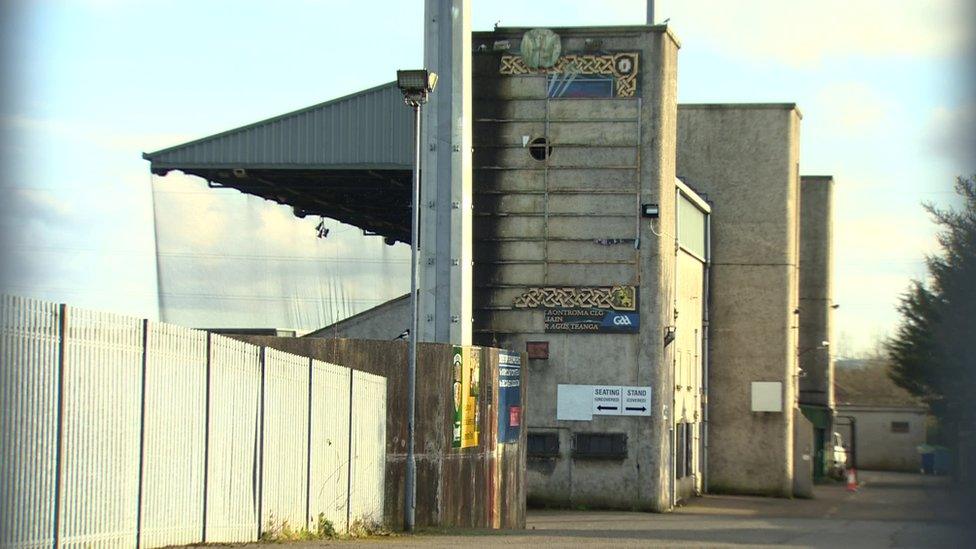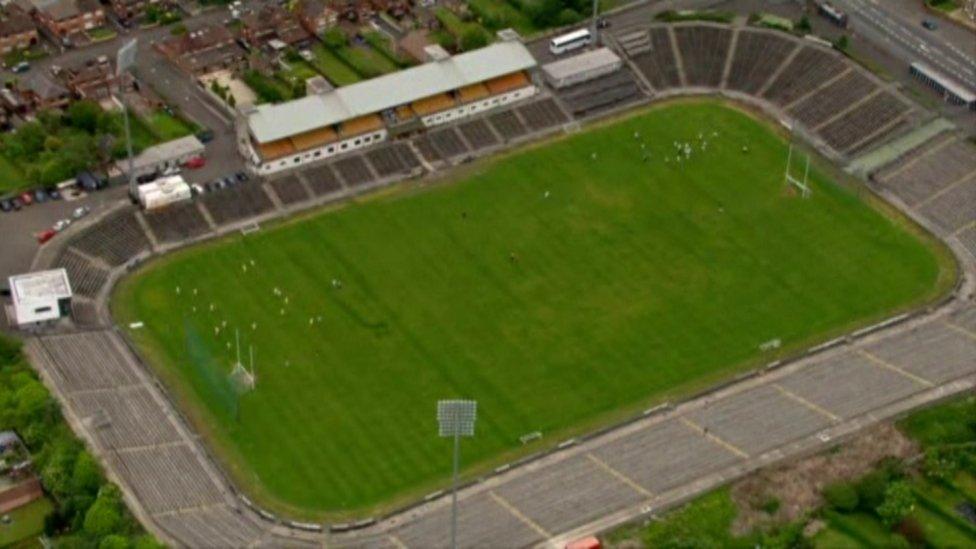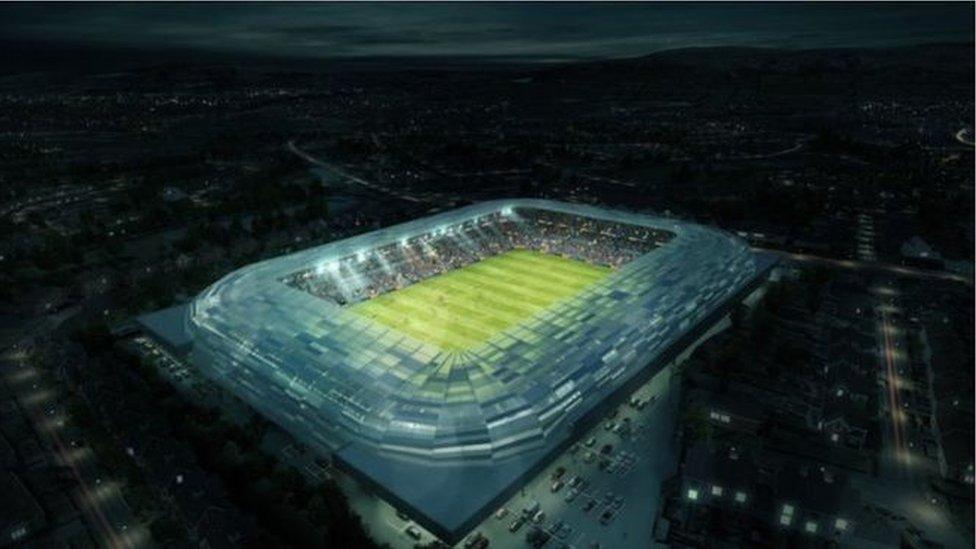Casement Park: What is the future for Belfast's GAA home?
- Published

The new stadium has a proposed capacity of 34,186
If a book is ever written about the recent history of Casement Park stadium in Belfast, librarians will have difficulty deciding whether to put it in the sport, politics or economics section.
Alternatively, it could end up on the fiction shelves, if the plans for a new 34,500-capacity modern stadium fail to become reality.
As things stand, the project is on track. Planning authorities have given the green light.
If all goes according to schedule, the GAA (Gaelic Athletic Association) will be hosting games at the new Casement Park in the summer of 2023.
Ulster senior football championship finals and All-Ireland qualifiers are planned for the stadium.
It could also be used as an outdoor venue for up to three music concerts a year.
What could possibly go wrong?
The short answer is a cash shortage or legal action - or both.
The long answer is that if you look back at the history of the project, it has been plagued by problems.
Once upon a time, the idea was to have a combined sports stadium - GAA, soccer and rugby - based at the site of the former Maze Prison near Lisburn.
That plan was scrapped in 2009 by the then Sports Minister Gregory Campbell of the DUP.
Instead, it was decided that the Stormont Executive should help fund an upgrade to the existing stadiums used by the GAA, soccer and rugby:
Casement Park in west Belfast
Windsor Park in south Belfast
Ravenhill stadium in south-east Belfast
The first redevelopment to be completed was the 18,000-capacity rugby stadium at Ravenhill.
Now called the Kingspan Stadium, work finished in May 2014.
Next was the 18,500-capacity revamped Windsor Park soccer stadium in October 2016.
As for Casement Park, it lies empty, decaying with every passing day.

The existing Casement Park stadium has fallen into disrepair
There has not been a ball kicked at the stadium for seven years - all the action has been off the pitch:
2013 - planning permission granted for a 38,000 capacity stadium
2014 - planning approval quashed
2015 - review of how project was handled
2017 - application for smaller 34,500-capacity stadium
2020 - Dept for Infrastructure planning approval
'Extremely disappointed by decision'
Much has been said on TV and radio since planning permission was granted but there has been silence on the airwaves from the west Belfast residents who have vehemently opposed the new stadium.
In a short message on their Facebook page, the Mooreland & Owenvarragh Residents Association wrote: "Obviously, we're extremely disappointed with the decision.
"The management report accompanying the decision is very long, running to 107 pages. We need to study that in detail. We'll take a view on the next steps once we've done that."
The group should not be underestimated; they have successfully challenged planning permission before.
As far as they are concerned, building the biggest stadium in Belfast in a heavily-populated residential area is grossly unfair.
Allow Facebook content?
This article contains content provided by Facebook. We ask for your permission before anything is loaded, as they may be using cookies and other technologies. You may want to read Meta’s Facebook cookie policy, external and privacy policy, external before accepting. To view this content choose ‘accept and continue’.
There is one final issue worth exploring - money. The new Casement Park is going to cost more than £100m.
If you dust down a copy of the recent NI Audit Office (2019) report on major capital projects, you can see how the price has risen in recent years from an original estimate of £77.5m to its current estimated cost of £110m.
Where is the extra £32.5m going to come from?
It is a question I put to Communities Minister Carál Ní Chuilín.
"The money's going to have to come from the executive," she told me.
"This is, and has been, part of every programme for government from 2010 right through and I would be astonished if the executive didn't back this proposal."
However, in the NI Assembly chamber, First Minister Arlene Foster indicated the GAA may have dig into its own pocket too.
"There will have to be discussions with Ulster GAA in relation to that (costs), because at the time that this was agreed, it was agreed at a level that was showing parity across the three sporting codes at that time," she said.

An aerial view of the old Casement Park stadium
The amount of public funding given to soccer and rugby was:
•£16.5m to fund Ravenhill upgrade
•£31m to fund Windsor Park redevelopment
The money was all paid pre-coronavirus when the public purse was much healthier.
The GAA's finances have also since taken a hit.
What will happen next at Stormont?
A business case for the Casement project will go to Finance Minister Conor Murphy and then to the executive for approval.
It all brings to mind a quotation from the economist Tony Whitehead who was involved in the very early stages of the sports stadium project 15 years ago.
He said: "As a sports fan, I would love this project to happen. As an economist, I am well aware that it needs to stack up."
The financial aspect remains key.
The next chapter of the Casement Park story is about to be written.
What happens with the accountants, and maybe the lawyers, will decide whether the builders get a mention and if it all ends happily ever after.
- Published15 March 2019

- Published13 October 2020
